
At a Glance:
How Much Water Does a Washing Machine Use?
6 Washing Machines to Help Save Water
Tips for Saving Water While Doing Laundry
Being eco-friendly is a big deal these days, and for good reason. It is always important to consider our environment when using energy to keep our household appliances running. Some appliances use an excess of water, which is not only a waste of energy, but also a waste of a resource. Not to mention, it can make for a sizeable water bill - something we all certainly want to avoid! Washing machine water waste may not even be something that was on your radar. Today we are going to fix that. We will answer the question, "How much water does a washing machine use?" After that, we will feature some of the top models on the market today to help you save water. Let’s dive in!
Explore Energy-Efficient Washers
Looking for an energy-effecient washer? Discover options from top brands like Maytag, Bosch, GE Profile, and more at Friedmans Appliance, today!
Shop Energy Star WashersTypes of Washing Machines
Front load and top load washers are two common types of washing machines, each with its own set of features and advantages. Both front-load and top-load washers serve the same primary purpose, which is to clean clothes. Plus, they each come equipped with a variety of wash cycles (i.e., normal, delicate, heavy-duty) to accommodate different types of fabrics and soil levels. Each type allows you to select the spin speed, which determines how fast the drum rotates during the spin cycle. Here are some of the key similarities and differences between the two types.
Top Load Washers
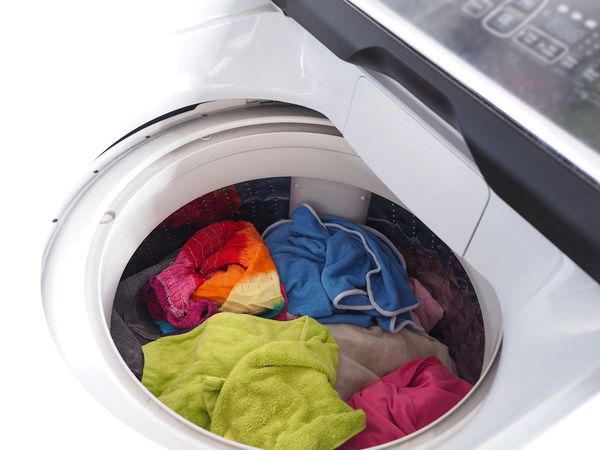
Top load washers have been a staple in households for decades. Their design allows users to load and unload laundry from the top of the machine, which can be more comfortable for those who prefer not to bend down. In terms of water usage, traditional top load washers with an agitator are known for consuming more water. They typically fill up the entire tub with water to create the necessary agitation to clean the clothes effectively. Top load models with agitators can often be more abrasive on clothes. However, newer models with impellers have improved washing performance greatly.
However, newer models of top loaders have been developed to be more water-efficient. Some of these high-efficiency top load washers do not have an agitator; instead, they use a plate at the bottom or other methods to move the laundry through a smaller amount of water. They also have sensors to adjust the water level according to the size of the load, further enhancing their water conservation. While they are generally better at saving water than their older counterparts, they still often use more water than front load washers.
Front Load Washers
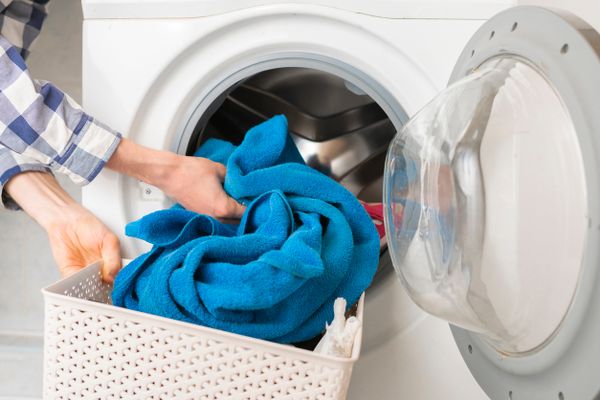
Front load washers are known for their efficiency, especially when it comes to water usage. Their horizontal-axis drum uses gravity to tumble clothes through a small amount of water, thus requiring significantly less water than top load washers. The side-mounted drum opens at the front, which means clothes need to be loaded and unloaded from the front of the machine—a design that might require bending down or kneeling.
Front load washers are also typically more energy-efficient because they use less water, which means less energy is needed to heat the water. The high spin speeds reduce the water content in the clothes after the wash cycle, leading to shorter drying times and further energy savings.
The main differences in water usage between top load and front load washers are based on their design and operation. Front loaders are at the forefront for water conservation and energy efficiency. However, high-efficiency top loaders offer a middle ground with improved water usage over traditional top load models and the convenience of not having to bend over to load the laundry. When choosing between the two, consider not just water and energy savings but also ergonomics, the price difference, and the layout of your laundry space.
→ Learn more: Why Does My Washer Smell Like Mildew?
How Much Water Does a Washing Machine Use?
Your washing machine water usage can vary significantly based on a few factors, including the brand, type of washer, and whether the machine is ENERGY STAR certified. If you have found yourself asking questions like, “How much water does a top loader washing machine use?” you will find your answers here. Here is a general overview of water usage in washing machines
Standard Washing Machines
Traditional top load washers with agitators tend to use the most water. These machines can use anywhere from 30 to 45 gallons of water per load. Some newer top load washers, known as high-efficiency without agitators, using an impeller or similar technology, are more water-efficient. They typically use about 15 to 30 gallons of water per load. Front load washers are generally the most water-efficient. They typically use only about 13 to 25 gallons of water per load. This is because they rely on the drum's tumbling action and gravity to move clothes through the water.
Energy Efficient Washing Machines
ENERGY STAR-certified washing machines, whether top load or front load, are designed to be more water-efficient and energy-efficient. How much water does a high efficiency washing machine use? Well, they can use up to 40% less water than standard washers. The actual water usage can vary from model to model, so it's a good idea to check the specifications provided by the manufacturer. Some manufacturers offer washing machines with specific water-saving features and advanced technologies that can reduce water consumption even more.
To get specific information about water usage for a particular washing machine, you can refer to the product specifications provided by the manufacturer. Additionally, many modern washing machines come with various settings and options that allow you to control water usage, so you can customize the water level for each load based on the size and soil level of the laundry.
6 Washing Machines to Help Save Water
If you’re looking to invest in a washing machine that will help you save on water, then check out these six different options!
Samsung 5.5 Cu. Ft. Brushed Black Top Load Washer
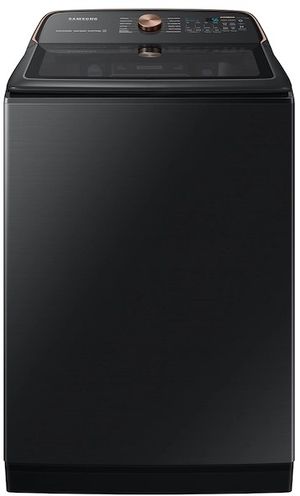
Shop this Samsung 5.5 Cu. Ft. Brushed Black Top Load Washer
This top load washing machine offers a spacious drum capacity, which is perfect for large loads. It incorporates cutting-edge technology for efficient and powerful cleaning and contains various wash cycles that cater to different fabric types. This washer is also equipped with a self-cleaning feature, ensuring long-lasting performance, as well as WiFi connectivity capabilities and Vibration Reduction Technology+. And most importantly, it’s designed for water conservation, using only approximately 15-30 gallons per load, making it a sustainable choice for eco-conscious consumers.
- Model: WA55A7700AV
- Dimensions: (H) 45.81” x (W) 27.56” x (D) 29.44”
- Capacity: 5.5 Cu. Ft.
LG 5.0 Cu. Ft. White Front Load Washer

Shop this LG 5.0 Cu. Ft. White Front Load Washer
When it comes to front load washers, this model offers exceptional features for all of your laundry needs. If you have asked yourself, “How much water does a front load washer use?” you will be pleased with this machine. Its spacious drum accommodates large loads, reducing the number of cycles needed, and it will amaze you with all of its advanced features like TurboWash™ technology, which ensures thorough cleaning in less time. This ENERGY STAR-certified washer is highly water-efficient, using approximately 13-25 gallons per load, a great option for those looking to monitor their water usage.
- Model: WM4200HWA
- Dimensions: (H) 39” x (W) 27” x (D) 33.25”
- Capacity: 5.0 Cu. Ft.
→ Learn more: LG Front Load Washers Reviewed: Top Picks
Bosch® 800 Series 2.2 Cu. Ft. White Front Load Compact Washer
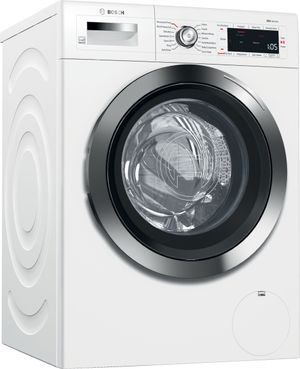
Shop this Bosch® 800 Series 2.2 Cu. Ft. White Front Load Compact Washer
This front load washing machine offers incredible efficiency and performance. Its compact size is perfect for small spaces, and it has advanced features like ActiveWater® Technology, which adjusts water usage to match the load, ensuring optimal efficiency. This model consumes only 13 gallons of water per cycle, so you can trust it is highly water-efficient. Additionally, it boasts a high spin speed for effective drying, saving both time and energy, as well as EcoSilence™ Motor, so laundry day won’t impact the peace of your home. This model will add nothing but benefits to your laundry experience!
- Model: WAW285H2UC
- Dimensions: (H) 33.25” x (W) 23.5” x (D) 25”
- Capacity: 2.2 Cu. Ft.
Crosley Professional® 4.5 Cu. Ft. White Top Load Washer
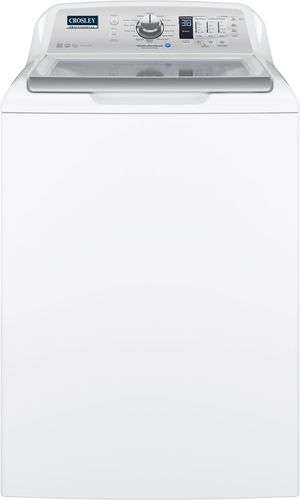
Shop this Crosley Professional® 4.5 Cu. Ft. White Top Load Washer
This model from Crosley promises a top-notch performance with a spacious drum capacity of 4.5 cubic feet, which is perfect for large loads. Its advanced features include a variety of wash cycles, customizable water levels, and a powerful agitator for thorough cleaning. This washer is designed to be water-efficient, using approximately 15 to 30 gallons per load, making it an excellent choice for both performance and resource conservation.
- Model: YTW4514SNWS
- Dimensions: (H) 46” x (W) 27” x (D) 27”
- Capacity: 4.5 Cu. Ft.
GE Profile™ 5.0 Cu. F.t White Top Load Washer
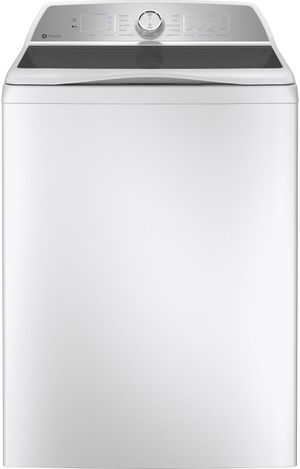
Shop this GE Profile™ 5.0 Cu. F.t White Top Load Washer
This top loader washing machine uses advanced technology and spacious capacity for efficient laundry care. Its impressive 5.0 cubic feet drum accommodates large loads, reducing the number of cycles needed, plus, it is equipped with innovative features like SmartDispense™ and built-in WiFi for added convenience. Additionally, its water-saving options make it an eco-conscious choice, offering both convenience and sustainability in one powerful appliance.
- Model: PTW600BSRWS
- Dimensions: (H) 43.88” x (W) 27.88” x (D) 28.19”
- Capacity: 5.0 Cu. Ft.
Maytag® 5.0 Cu. Ft. White Front Load Washer

Shop this Maytag® 5.0 Cu. Ft. White Front Load Washer
This machine boasts excellent cleaning performance with its spacious drum and advanced technology. It ensures thorough cleaning while using minimal water, making it highly water-efficient, and it comes equipped with a range of convenient features, including multiple wash cycles, an Extra Power button, and a Late Add feature. Its durable construction and sleek design make it a reliable and attractive addition to any laundry room.
- Model: MHW8630HW
- Dimensions: (H) 38.63” x (W) 27” x (D) 32.94”
- Capacity: 5.0 Cu. Ft.
→ Learn more: 5 Luxury Washer and Dryer Bundles Worth the Investment
Tips for Saving Water While Doing Laundry
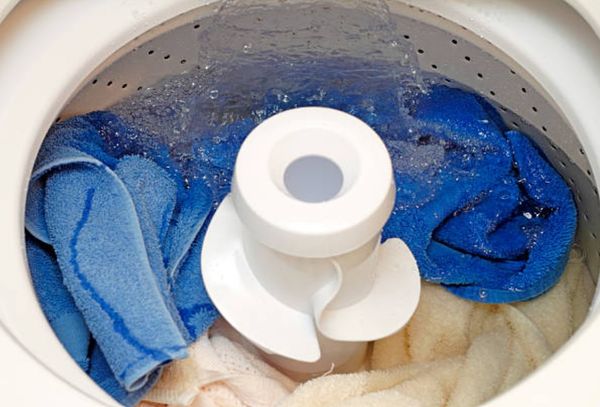
Here are a few ways you might save water while doing your laundry:
✓ Opt for Full Loads: Running your washing machine only when it's full can significantly reduce the amount of water you use. By consolidating laundry days and ensuring a full load each time, you maximize the efficiency of every wash cycle, which can lead to substantial water savings over time.
✓ Choose High-Efficiency Machines: High-efficiency washers are designed to use less water and energy per load. They often come with settings that adjust the water level based on the weight and type of fabric, ensuring that no water is wasted.
✓ Adjust Water Levels: For machines that allow manual control, adjust the water levels according to the size of your laundry load. Avoid using the full water setting for small loads; this simple step can save gallons of water per cycle.
✓ Presoak Stains So No Extra Rinse Needed: Treat stains by presoaking garments rather than running them through multiple rinse cycles. This can effectively remove stains without the need for extra water or extended washing cycles.
✓ Upgrade Your Washer: If your washer is an older model, consider upgrading to a newer, more water-efficient model. Modern washers have better technology for managing water usage without compromising on cleaning performance.
✓ Fix Leaks Promptly: Regularly check your washing machine hoses and connections for leaks. A small drip can waste a lot of water over time, so fixing leaks promptly will prevent water wastage.
✓ Avoid Overdosing Detergent: Using too much detergent can create excess suds, requiring additional rinse cycles to remove. Stick to the recommended detergent amount to ensure a single rinse is sufficient.
✓ Repurpose Towels and Linens For Less Washing Need: Instead of washing towels and linens after a single use, hang them to dry and reuse when possible. This habit can significantly reduce the frequency of laundry loads.
✓ Air Dry When Possible: Using a clothesline or drying rack not only saves energy but also reduces the need for the water used in the washer's spin cycle. Air drying is gentle on fabrics and can extend the life of your clothes.
✓ Upgrade Faucets and Hoses to Low Flow Water Options: Install low-flow faucets and hoses to reduce the water flow to your washing machine. This can save water without affecting the washing machine's performance. These devices are designed to maintain water pressure while using less water.
→ Learn more: How Much Water Does a Dishwasher Use?
FAQs
How much water does my washer use?
The water usage of your washing machine depends on the type, brand, and model. On average, it can range from 13 to 45 gallons per load.
How much water does a dishwasher use?
A standard dishwasher uses around 3 to 7 gallons of water per cycle, depending on its age, make, and settings.
What is Energy Star?
ENERGY STAR is a voluntary program by the U.S. EPA that identifies energy-efficient products and practices to help consumers and businesses reduce energy consumption and protect the environment.
Where to find washing machines near me?
While there are many places to shop for a washing machine, look no further than Friedmans Appliance. If they don’t have a physical location near you, their website offers incredible options and deals on a large variety of washing machine models. Shop for your next washer and dryer at Friedmans. I promise you will be pleased with your entire experience.
Why Trust Friedmans Appliance?
Established in 1922, Friedmans Appliance has been the most trusted name in the Bay Area for over 100 years. What started as a small appliance store in Oakland has expanded to include every appliance you need for your home. Our commitment to value, inspiration, and character has only grown, creating an unbeatable reputation for top-notch appliances. At Friedmans, we strive to give our customers the best of the best, including our selection of top appliance brands and our exceptional customer service. Speaking of which, we offer a 100-day price guarantee on all our products — the longest in the industry!
Our wide selection of appliances is just one of the reasons we’re the best Bay Area appliance store. We carry refrigerators in every style, every cooking appliance to show off your chef skills, and every dish care and laundry appliance you need for cleanup.
Shop Washers at Friedmans
See for yourself why Friedmans is a trusted name in the Bay Area and shop washers online. While we are located in Pleasant Hill, we deliver to all of Northern California — even Reno! If you have any questions, our team is always happy to help you find an answer to the question, "how much water does a washing machine use" or find a new washer, whether you call us at 925-808-2950, email us, or use our online chat feature. Better yet, stop by our appliance store in Pleasant Hill to experience the quality in person. Visit us today!
→ Learn more: 3 Perks of Stackable Washer and Dryers


